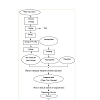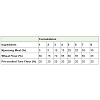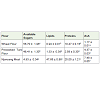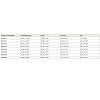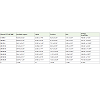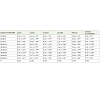Research Article
Incorporation of Ricinodendron heudolotti Meal into Blends of Wheat and Precooked Taro Flour for Production of Nutrient Dense Biscuits
Edith N Fombang1*, Julien Armel Assiene Agamou1 and Carl MF Mbofung1,2
1National School of Agro-Industrial Sciences (ENSAI), Department of Food Science and Nutrition, University of Ngaoundere, BP 455, Ngaoundere, Adamawa Region, Cameroon
2 College of Technology, University of Bamenda, P.O. Box 39, Bambili, North West Region, Cameroon
Corresponding author: Edith N. FOMBANG, National School of Agro-Industrial Sciences (ENSAI), Department of FoodScience and Nutrition, University of Ngaoundere, BP 455, Ngaoundere, Adamawa Region, Cameroon, Tel: (+237) 675 19 5786; E-mail: edfombang@yahoo.fr
Citation: Fombang EN, Agamou JAA, Mbofung CMF. Incorporation of Ricinodendron heudolotti Meal into Blends of Wheat and Precooked Taro Flour for Production of Nutrient Dense Biscuits. Indian J Nutri. 2016;3(2): 131.
Copyright © 2016 Fombang EN,et al. This is an open access article distributed under the Creative Commons Attribution License, which permits unrestricted use, distribution, and reproduction in any medium, provided the original work is properly cited.
Indian Journal of Nutrition | ISSN: 2395-2326 | Volume: 3, Issue: 2
Submission: 06/07/2016; Accepted: 21/07/2016; Published: 01/08/2016
Abstract
Protein energy malnutrition remains the biggest nutritional problem in children under five years in developing countries. Provision of nutritious snack foods to children could go a long way in resolving this problem. Composite flours of wheat (45-80%), precooked taro flour (20%) and njansang meal (0-35%) were studied for the production of energy and nutrient dense biscuits. Chemical composition of flours and biscuits were determined, as well as the physical and sensory properties of biscuits. Nutritional evaluation of biscuits was carried out to determine its contribution to protein and energy RDA of children 3-5 yearsold. Results show that protein, lipid, and ash contents of flours increased by 84%, 105% and 221% respectively at 35% incorporation of njansang meal. Biscuit diameter and spread ratio decreased, while weight and thickness increased with njansang meal incorporation. Njansang meal improved nutritional quality of biscuits. Best organoleptically accepted biscuits were obtained with a combination of 55% wheat flour, 20% precooked taro flour and 25% njansang meal, with energy and protein values of 398 kcal and 11.22 g respectively per 100g of biscuit. Thus, 100 g of biscuits could supply respectively 86.4% and 33.2% of proteinand energy needs of children 3-5 years old.
Keywords: Composite flour (wheat, precooked taro and Njansang); Biscuit nutritional quality; Sensory analyses; Biscuit physical characteristics
Introduction
Undernutrition in children manifesting as stunting, underweight and wasting remains the biggest nutritional problem in manydeveloping countries in Asia, Latin America, the Middle East, andAfrica [1]. They are a major contributing factor to child mortality,disease and disability [1]. Globally, 165 million children are stuntedand undernutrition is responsible for 3·1 million deaths annually inchildren younger than 5 years [2]. Undernutrition early in life hasmajor consequences for future educational, income and productivityoutcomes. Stunting is associated with poor school achievement and poor school performance [3].
The absence of nutritious foods in quantity and quality stands outas one of the major causes of malnutrition (Protein energy malnutrition- PEM), alongside poor health care and hygienic practices. This formof malnutrition (PEM) usually sets in as from six months of age,which coincides with the introduction of complementary foods intothe diets of children, although, poor nutrition during pregnancy isalso a contributing factor [4]. To meet children’s nutritional needsat this stage and to help resolve the problem of malnutrition inchildren under five years of age, much effort is being consecrated to the development and provision of nutrient dense complementaryfoods to children as from the age of weaning [5]. Unfortunately,the problem still persists and is even degenerating in some areas,continuing into adolescence with devastating consequences on childdevelopment [1]. Most weaning foods given to children in developingcountries are made of starchy gruels with low protein and mineralcontents [5]. To complement the nutrient intake of children 2-5 yearsold, snacks such as biscuits are increasingly being given to them [6].Biscuits could thus be used as a vehicle to provide nutritious snackfoods to children through fortification of wheat flour with proteinand lipid rich flours. Biscuits of acceptable textural and organolepticproperties have been developed with partial replacement of wheatflour with flours produced from local foodstuffs such as beniseed andplantains [7]; taro tubers [8] and chickpea and plantains [9].
In an effort to improve the utilization of taro tubers, Himeda etal. [9] prepared organoleptically acceptable biscuits by replacing 20%of wheat flour with precooked taro flour. These biscuits however,were of low protein content (9.5%). Taro flour is poor in protein(1.0 to 4.5%), but rich in carbohydrates (60-90% DM) [10]. Itsstarch granules have a small diameter (1.5- 5μm) [11] conferring onit a good digestibility and a potential for use in the development ofchildren foods. It is high in the minerals phosphorus, potassium andmagnesium [12]. Its fiber content varies from 5.02 to 9.01% and ismostly soluble fiber [10].
Oilseeds, such as njansang (Ricinodendron heudelotii, Bail.),mostly used as ingredients in food preparations have been shownto contain important amounts of proteins (22-31%) similar tolegumes, with a high lipid content (45%) made up essentially (79%)of polyunsaturated fatty acids (PUFA), and a non-negligible ashcontent [13,14]. Significant levels of vitamin A and E, have beenreported in these seeds along with a good percentage of essential tototal amino acids (40.6%) [13]. Its high protein and polyunsaturatedfatty acid content, could be exploited in the production of novelfoods such as biscuits to improve their nutrient density while alsobringing in much needed PUFA, with beneficial effects on the growthand wellbeing of children. It would equally contribute to valorizinglocal food resources. The objective of this work was thus to evaluatethe use of composite flours of wheat/precooked-taro/njansang, forthe production of energy and protein dense biscuits and to evaluatetheir acceptability and nutritional quality as potential snack foods forchildren less than five years old, to help in the fight against proteinenergy malnutrition.
Materials and Methods
Biological Materials
The plant materials used for this work were taro tubers (Colocossiaesculenta) harvested from Bafia (Centre Region, Cameroon), Njansangseeds (Ricinodendron heudelotii) and wheat flour purchased from alocal market in Ngaoundere, Cameroon.
Methods
Production of taro flour
Pre-cooked Taro flour was produced as depicted in Figure 1. Taro tubers were washed and cooked in their peels using a pressurecooker for 15 mins. Boiled tubers were then peeled manually andcut into slices 0.5 cm thick. Slices were dried at 45 °C for 24 h inan electric dryer (Riviera and Bar L0075). Dried taro slices weremilled using a laboratory mill (Cullati, Polymix, France, Kinematica,Luzernerstrasse, Germany), and sieved through a 500 um sieve. Theflour obtained was sealed in polythene bags and stored at freezingtemperatures until needed. Njansang seeds were sorted and milled ina blender to obtain a meal.
Preparation of Composite Flours
To prepare composite flours, taro flour in the mixture was fixedat 20% following previous findings by Himeda et al. [8] that thislevel of substitution produced biscuits of acceptable organolepticcharacteristics. The concentration of wheat flour and njansang mealwas then varied to give incorporation levels of 0 - 35% njansang mealand 80 - 45% wheat flour (Table 1).
Preparation of biscuits
Biscuits were prepared according to Himeda et al. [8]. Sugar (125g), margarine (125 g) and eggs (2) were creamed together in a foodprocessor (Clatronic, Profi Cooks KM 2961, Germany) until lightand fluffy. The amount of fat added was adjusted in accordance withthat initially present in the composite flour to give a final fat contentof 125 g. Composite flour (250 g) salt (2 g) and 5 g baking powderwas mixed together and added to the creamed mixture, and mixingcontinued to obtain a uniform dough. The dough was then rolled outinto a continuous sheet of approximately 0.5 cm and cut into roundpieces using a biscuit cutter. Baking was done at 180 °C for 15 minsin an oven. The biscuits were cooled and kept frozen until neededfor analyses. Biscuits for sensory analyses were cooled and usedimmediately.
Analyses
Proximate Composition: Precooked taro flour, wheat flour,njansang meal and biscuits were analysed for moisture, ash, proteinand lipid contents using AOAC [15] methods. Available sugarswere determined according to Fischer and Stein, [16] followingacid hydrolysis of samples. The energy density of the biscuits wascalculated from the caloric value of the energy nutrients using theAtwater factor [17] where 1 gram of carbohydrate supplies 4 kcal, 1 gram of protein 4 kcal and 1 gram of fat 9 kcal.
Physical characteristics of biscuits: Weight (g) of biscuits was measured using a digital balance and was the average value of six individual biscuits. Biscuit thickness (cm) was determined by stacking six biscuits on top of each other and taking the average thickness. Diameter (cm) was the average value of six biscuits measured using a caliper [9]. Volume was determined by calculation. Spread ratio wascalculated by dividing the average value of diameter by the averagevalue of thickness of biscuits, and density as weight/volume.
Sensory evaluation of biscuits: Sensory evaluation of the biscuitswas carried out as described by Himeda et al. [8], using a consumerpanel of 56 persons and a 9 point hedonic scale where 1 stands fordislike extremely and 9 for like extremely. Sensory attributes evaluatedwere color, taste, texture, flavor, acridity and overall acceptability.
Statistical Analysis
Analyses were carried out in triplicates and results are presentedas means and standard deviations. Mean separation was doneusing the Duncan Multiple Range test. Stat graphics version 5.0(Manugistics, Rockville, Maryland, USA) statistical software was usedfor these analyses.
Results and Discussion
Chemical composition of flour samples
The proximate composition of wheat flour, precooked cookedtaro flour and njansang meal are presented on Table 2. Njansang meal had the highest concentration of lipids (47.66%), protein (25.05%) and ash (7.48%) contents (Table 2), consistent with the fact that it is an oilseed. Accordingly, it had the lowest available sugar content. Oil contents obtained in this study were similar to the 44.7% reported by Ezekwe et al. [13]. Previous studies had reported oil contents in njansang seeds to range between 49.25 and 63.48% [18].The protein content of njansang obtained in this study is comparable to the 22% reported by Tchiégang et al. [14], but lower than the 31% reported byEzekwe et al. [13]. Njansang could thus be a good source of protein for the diet.
Wheat flour is of intermediate protein content (10.47%), andthis is in agreement with values reported by Akubor and Badifu [19].Protein content for precooked taro flour found in this work fallswithin the range of 2.7 to 5.4% obtained by Mbofung et al. [20] intaro tubers. Taro like other tubers is poor in proteins and thus couldnot be envisaged as a protein source.
Available sugars were highest in wheat flour (56.70%) followedby precooked taro flour (48.41%). This is explained by the fact thatwheat and taro flours are made up predominantly of starch whichwhen hydrolyzed gives sugars. Available sugar contents of taro flouris comparable to that by Mbofung et al. [20] for raw white Ibo tarotubers (48.01%).
Wheat flour and taro flour had negligible oil contents incomparison to njansang (Table 2). The wheat flour used in this studywas refined wheat flour in which most of the germ had been removedand this explains its low oil content (0.94%). Tubers generally are poorsources of lipids. Lipid contents of precooked taro flour in this study(1.33%), were slightly higher than that (0.6%) reported by Himeda etal. [8], and (0.82%) by James et al. [21].
Ash content for njansang falls within the range of 6.94-7.61g/100g DM reported by Abubakar [22]. Lowest values in wheat flour could be attributed to the refining process which removed most of the bran where the minerals were concentrated. Ash content of taro flour (4.37%) was within the range of 3.5-7.5% reported by Mbofunget al. [20] for six varieties of taro. Taro tubers are reportedly high inminerals such as potassium and magnesium [23] amongst others andthus accounts for the high ash contents of taro tubers.
Chemical composition of composite flour mixtures
Composite flours prepared using blends of 20% precooked taroflour, 0 to 35% njansang meal and 80-45% wheat flour, were analysedfor their proximate composition (Table 3). Available sugar contentdecreased significantly (p< 0.05) with increasing incorporation ofnjansang meal (Table 3). Given that taro flour composition wasconstant and that wheat flour had the highest sugar content (Table 2), it follows therefore that its substitution with njansang mealbrought about a reduction in sugar content of the composite flour.Sugar content dropped by as much as 29% with incorporation of 35%njansang meal. On the other hand protein, lipid and ash contentsof composite flours increased significantly (p< 0.05) with increasingincorporation of njansang meal, and is in correlation with the highconcentration of these nutrients in njansang meal (Table 2). At35% incorporation of njansang meal, protein, lipid and ash contentincreased by 84%, 105% and 221% respectively (Table 3). It emerges from these analyses that incorporation of njansang meal into wheat taro flour improves the latter’s nutritional quality to give flours that could be utilized for the production of biscuits of good nutritional and energy value.
Nutritional Composition and Energy value of biscuits
Biscuits prepared using the different composite flour mixtures were analysed for their nutritional composition. Available sugars inbiscuits decreased with incorporation of njansang meal as observedwith the composite flours (Table 4). This observation is consistentwith the fact that the amounts of the other ingredients used in theproduction of the biscuits were identical, thus differences in nutrientcomposition resulted mainly from the composition of the flour used.On the other hand protein and ash content in biscuits increased withincorporation of njansang meal in accordance with observationsmade in the flours (Table 3). Lipid contents appeared stable inbiscuits because the amount of margarine added was adjusted to takeinto consideration the initial lipid contents of the flours.
The quantities of available sugars in cookies was however smallerthan those observed with the flours. Similarly, protein contents ofbiscuits were lower than in the corresponding flours. The decreasesin sugars and protein contents of biscuits compared to flours couldbe attributed to maillard type reactions involving sugars and proteinsas well as caramelisation of sugars that occur during baking [24].These reactions, although they negatively affect proteins and sugars,contribute to the development of color and flavour in biscuits [24].
Interestingly, the energy content of the biscuits were similar(p>0.05). This could be as a result of the fact that the lipid contentsof the biscuits were identical and the decrease in available sugarsobserved with substitution by njansang meal was compensated by a corresponding increase in proteins, both of which are similarin energy density; supplying each 4 Kcal per gram of nutrient. Thedifference in these biscuits therefore is not in the amount of energythey supply but in their nutritional composition such as the amountand quality of their proteins as well as in the quality of their oils.Although the biscuits all have similar oil content, the type of oil differ and likewise their fatty acid composition, as some biscuits have more njansang oil than others. Njansang oil is rich in polyunsaturatedfatty acids - PUFA (79%) [13,14], with the most abundant being α-eleostearic acid which represents about 51% of its total fatty acidscontent followed by linoleic acid (28%) [14]. Thus biscuits with highconcentration of njansang had more of these PUFA. With their highcontent of PUFA, and other antioxidant nutrients such as Vitamin Aand E [14] they could enhance nutritional status and promote healthygrowth in children [25].
The amino acid profile of njansang cake shows that it is limitedin the essential amino acid lysine, but has a good essential amino acidto total amino acid ratio (40.6%) slightly above that for a balancedprotein (33%) [13]. This implies that njansang protein is of good nutritional value and can thus be expected to support growth. Thishas actually been supported by the works of [13], who demonstratedthat pigs fed meals containing njansang had growth rates comparableto those fed a control diet, and the carcasses of the animals were ofbetter nutritional quality. From these, it can be expected that cookieswith a high proportion of njansang are nutritionally superior to thosewith lower concentrations and could contribute to improving thenutritional status of growing children who need high amounts ofgood quality proteins and essential fatty acids [25]. Worthy of note,is the fact that protein contents in the biscuits were improved by over100% with the incorporation of njansang meal at levels of 35% intocomposite flours.
Physical characteristics of biscuits
Biscuits were analysed for their physical characteristics; weight,diameter, thickness, density, spread ratio, and the results arepresented on Table 5. Diameter and spread ratio of biscuits generallydecreased significantly (p = 0.0001) with incorporation of njansangmeal compared to control (100% wheat flour). On the other hand,thickness, density and volume increased significantly (p = 0.0001) with substitution of wheat flour by njansang meal (Table 5). Yadavet al. [9] reported increases in spread ratio of biscuit when wheatflour was supplemented with plantain and chickpea flour. Biscuitweight however, remained constant with incorporation of up to 25%njansang meal and thereafter increased. Similar observations havebeen made by Rezzoug et al. [26] of no variation in biscuit weightwhen wheat flour was substituted with protein flour at levels of up to20% protein.
These changes in biscuit physical characteristics could beattributed to differences in protein contents of the composite flouras a result of substitution of wheat flour with njansang meal. Thequantity and quality of the proteins present in flour have a major rolein influencing the rheological behaviour of the dough, and of biscuits,as they influence water absorption capacity of dough. The greater theprotein content, the more water it absorbs. Addition of proteins willthus lead to an increase in dough extension, and consequently, theshrinkage of dough after cutting would be considerable [26]. Also,the presence of gluten proteins allows biscuit dough to form a goodprotein network that entraps air and spreads, but given that njansangmeal has no gluten, it reduces the spread of the biscuits duringcooking, thus giving thicker biscuits. These explain the decrease indiameter and in spread ratio, as well as the increase in thickness ofbiscuits with increased njansang concentration.
Sensory analyses of biscuits
Substitution of wheat flour with taro flour had no significantinfluence on biscuit sensory characteristics (Table 6). This is in accordance with previous observations by [8], that incorporation of precooked taro flour into wheat flour at levels up to 30% produced biscuits of acceptable organoleptic properties; although beyond 10% the acceptability was slightly lower than with wheat biscuits.
In general, incorporation of njansang meal into wheat taro blenddid not significantly (p>0.05) affect the color, texture, flavor, acridity and overall acceptability of the biscuits (Table 6). On the contrary, the appreciation of the taste of the biscuits was significantly reduced with incorporation of njansang meal, with lowest values recorded at 35% incorporation. The decrease in the appreciation of taste may be attributed to the strong flavor of njansang. The absence of any perceived differences in the acridity of the biscuits is no surprise given that the amount of taro flour, which contributes to acridity, in the composite flour mixtures was identical. Oxalates have been associated with acridity in taro tubers [23].
The overall acceptability of the biscuits was strongly positivelycorrelated to flavour (r = 0.789), taste (r = 0.892) and acridity (r= 0.811), implying that these attributes contributed much to thegeneral acceptability of the biscuits. It is worth noting, that none ofthe biscuits were disliked, suggesting that these biscuits could actuallybe consumed especially if consumers are made to understand theadded nutritional benefit (increased protein content and quality,polyunsaturated fatty acids) that addition of njansang meal conferson these biscuits. In general, wheat biscuits were most appreciated.Amongst the njansang incorporated biscuits, the 25% was the mostappreciated. The least accepted was the 35%, probably due to thestrong njansang flavor. Acceptability could thus be improved by reducing the njansang flavor, through addition of flavor compounds.
Contribution of biscuits to RDA of preschool children 3-5Years Old
This consists in evaluating the contribution of 100 g of biscuitsthat could be used as daily snacks for preschool children 3 to 5 yearsold, with a daily energy recommendation of 1200 kcal, and 13 gprotein [25]. Considering biscuits with njansang meal incorporatedat 25%, as this was the best appreciated organoleptically, 100 g ofbiscuits supply 398 kcal and 11.22 g protein (Table 5). Therefore, 100g biscuits would meet respectively 33.2% and 86.4% of daily energyand protein needs for children 3 to 5 years of age. These biscuitscould thus be considered adequate as a snack for children in helpingto alleviate the problem of protein energy malnutrition.
Conclusion
It emerges from this study that organoleptically acceptablebiscuits of good nutritional quality, capable of meeting respectively86.4% and 33.2% of protein and energy needs of children 3-5 years oldcan be prepared using a combination of wheat flour, precooked taroflour and njansang meal at levels of 55, 20 and 25% respectively. Thiswould help in the fight against malnutrition and improve utilizationof local food crops.
References
- UNICEF (2013) Improving Child Nutrition: The achievable imperative for global progress. United Nations Publications Sales No. E.13.XX.4.
- Bhutta ZA, Das JK, Rizvi A, Gaffey MF, Walker N, et al. (2013) Maternal and Child Nutrition 2 Evidence-based interventions for improvement of maternal and child nutrition: what can be done and at what cost? Lancet 382: 452-477.
- Dewey KG, Begum K (2011) Long-term consequences of stunting in early Life. Matern Child Nutr 7 (suppl 3): 5-18.
- Black RE, Victora CG, Walker SP, Bhutta ZA, Christian P, et al. (2013) Maternal and child undernutrition and overweight in low-income and middle-income countries. Lancet 382: 427-451.
- Ferguson EL, Darmon N (2007) Traditional foods vs. manufactured baby foods. In: Agostoni C, Brunser O (eds): Issues in Complementary Feeding. Nestec Ltd., Vevey/S. Karger AG, Basel. Nestle Nutrition Workshop Series Pediatric Program 60: 43-63.
- Nazni P, Pradheepa S, Hasan A (2010) Effects of weaning biscuits on the nutritional profile and the cognitive development in preschool children. Ital J Pediatr 36: 18.
- Agu HO, Okoli NA (2014) Physico-chemical, sensory, and microbiological assessments of wheat-based biscuit improved with beniseed and unripe plantain. Food Sci Nutr 2: 464-469.
- Himeda M, Njintang NY, Fombang E, Facho B, Kitissou P, et al. (2014) Chemical composition, functional and sensory characteristics of wheat-taro composite flours and biscuits. J Food Sci Technol 51: 1893-1901.
- Yadav RB, Yadav BS, Dhull N (2012) Effect of incorporation of plantain and chickpea flours on the quality characteristics of biscuits. J Food Sci Technol 49: 207-213.
- Nip WK, Muchille J, Cai T, Moy JH (1989) Nutritive and non-nutritive constituents in Taro (Colocassia esculenta (L.) Schott) from American Samoa. Journal of Hawaiian Pacific Agriculture 2: 1-5.
- Njintang YN (2003) Studies on the production of taro (Colocassiaesculenta L. Schott) flour for the processing of Achu (A taro-based food). PhD Thesis, University de Ngaoundéré, Cameroon.
- Amon AS, Soro RY, Koffi PKB, Due EA, Kouame LP (2011) Biochemical characteristics of flours from Ivorian Taro (Colocasia esculenta, CvYatan) corm as affected by boiling time. Adv J Food Sci Technol 3: 424-435.
- Ezekwe MO, Besong SA, Johnson R (2014) Nutritive composition of Omega-3 fatty acids rich Ricinodendron heudelotii and its potential for nutrition. Int J Nutr Metab 6: 56-62.
- Tchiégang C, Kapseu C, Ndjouenkeu R, Ngassoum MB (1997) Amandes de Ricinodendron heudelotii (Bail.): matière première potentielle pour les industries agro-alimentaires tropicales. J Food Eng 32: 1-10.
- AOAC (1990) Methods of analysis of the Association of Official Analytical Chemists.15th edition, Arlington, Virginia 22201, USA.
- Fischer E, Stein EA (1961) DNS colorimetric determination of available carbohydrates in foods. Biochemical Preparation 8: 30-37.
- Omobuwajo OT (2003) Compositional characteristics and sensory quality of biscuits, prawn crackers and fried chips produced from breadfruit. Innovative Food Sci Emerging Technol 4: 219-225.
- Tiki MT, Fondoun JM, Kengue J, Tchiégang C (2000) Chemical composition of Ricinodendron heudelotii: An indigenous fruit tree in southern Cameroon. African Crop Sci J 8: 195-201.
- Akubor PI, Badifu GIO (2004) Chemical composition, functional properties and baking potential of African breadfruit kernel and wheat flourblends. Int J Food Sci Technol 39: 223-229.
- Mbofung CMF, Aboubakar, Njintang YNN, Bouba AA, Balaam F (2006) Physicochemical and functional Properties of six varieties of Taro (Colocasiaesculenta L. Schott) flour. J Food Technol 4: 135-142.
- James EO, Peter IA, Charles NI and Joel N (2013) Chemical Composition and Effect of Processing and Flour Particle Size on Physicochemical and Organoleptic Properties of Cocoyam (Colocasia esculenta var. esculenta) Flour. Nigerian Food Journal 31: 113-122.
- Aboubakar DAK (2005) Contribution à l’étude des conditions de production et des aptitudes technologiques des huiles des oléagineux non-conventionnels: cas de Ricinodendron heudelotii bail. Pierre ExPax et de Canariumschweinfurthiiengl.PhD Thesis, University of Ngaoundere, Cameroon.
- FAO (1990) Roots, tubers, plantains and bananas in human nutrition. Rome: Food and Agriculture Organization of the United Nations.
- Vaclavik VA, Christian EW (2008) Essentials of Food Science.3rdedn. Chapter 15, pp 351-376. New York: Springer.
- Whitney E, Rolfes SR(2011) Understanding Nutrition. 12th edition.USA: Wadsworth, Belmont.
- Rezzoug ZM, Bouvier JM, Alla K, Patras P (1998) Effect of principal ingredients on rheological behaviour of biscuit dough and on quality of biscuits. J Food Eng 35: 23-42.

